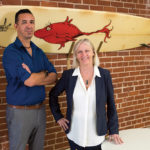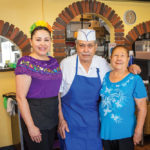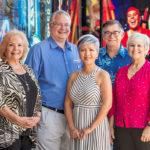Amber Sheikh Ginsberg is having a moment. The 34-year-old homeless advocate and consultant has emerged as one of the Harbor Area’s strongest voices for finding solutions to our current homeless crisis. Last year, she spearheaded the formation of the CD15 Working Group on Homelessness, which provides up-to-date information to neighborhood councils and advocacy groups in order to find answers to help alleviate the current crisis. A San Pedro resident and mother of two, the UC Davis grad was recently feted by the San Pedro Chamber of Commerce as their 2019 Leadership Award recipient for her continued advocacy work.
Passionate and outspoken, Ginsberg recently sat with San Pedro Today to discuss the current state of homelessness in San Pedro, what’s being done to help solve the crisis, and what residents can do to help.
The interview has been edited for length and clarity.
San Pedro Today: How did you get started in homeless advocacy work?
Amber Sheikh Ginsberg: I’ve worked in homeless services and poverty alleviation for 15 years, working with various nonprofits. I actually started my work in poverty alleviation in India. I grew up in the South Bay and while in college, went to Delhi on a fellowship/research trip through both the United Nations and UC Davis to research microfinance, which are small loans to impoverished people. I was brought over because my major was international relations (with minors in women’s and gender studies), and I speak Hindi. I’m half South Asian. In Delhi, I worked for a local nonprofit implementing UN microfinance programs. In the end, the nonprofit needed more help with fundraising and strategic planning, and I realized I was better at that than working directly with clients. I have more of a business and strategic mind when it comes to solving issues. I love working with people one-on-one, but I’m just not meant to be a social worker.
What brought you back to working in Los Angeles?
I love this city and I love the South Bay. Unfortunately, I realized I didn’t need to go to India to work with poverty at its worst, and the systems that created and perpetuate it. It was right here.
I ended up at the Downtown Women’s Center where I started working in homeless services. I worked on Skid Row right out of college. After that, I worked with an organization serving homeless children and their families in Long Beach and did some work for Marymount California University for a couple of years before ending up at Thurlow/Associates — a nonprofit consulting firm —where I’m the managing senior associate.
I still work in homeless services, but as an organizational development consultant. At Thurlow/Associates, I work with social justice and social service organizations, helping them become stronger so they can do the work they need to do. I build the capacity of organizations so that their impact can be greater. Homeless services have always been where I felt most passionate, especially as it pertains to women and children.
You’re known for being a strong and vocal advocate for homeless solutions. With your background and education, you could have gone into any number of industries. What fuels your passion about homeless advocacy?
One of the many reasons this issue is so important to me is because I suffered from really intense perinatal mental health issues during my second pregnancy. I think this is why I became such a strong advocate at this point in my life. Halfway through my second pregnancy, I had a massive panic attack in the middle of the night. And they kept going. After three days of not sleeping, I ended up in Torrance Memorial. I felt crazy at that point.
At that time, I was actually working back on Skid Row as a contractor for the Downtown Women’s Center. I had this ‘aha’ moment after essentially not sleeping for a week. I’m pregnant, with a two-year-old at home, and I realized the only difference between me and the women we were serving was that I had resources and a safety net. As part of my healing process, I determined that I was never going to look away from someone else experiencing this.
Suffering from mental health issues derailed me in a manner that I can’t even articulate, but it also grounded me in this work in such a deep way. If I didn’t have a safety net, I would have done anything to feel better at that point. I would have lost everything.

(photo: John Mattera Photography)
You’ve lived in San Pedro for a decade with your husband and two children, so you’ve witnessed firsthand how our homeless problem has devolved into a crisis, especially around the Beacon Street post office. As someone who works with these issues on a daily basis, what do you see when you drive past the post office?
It’s horrible. I actually spend less time in that encampment. I spend more time in Harbor City, which has our largest encampment in the council district around Lomita Blvd. It’s huge. On any given night, you can have between 40 and 90 individuals there.
When I drive by any of the San Pedro encampments, I know they represent only 10 percent of the actual homeless population in our area. Maybe 15 percent at most. It’s just the tip of the iceberg, and it’s also the most exacerbated and most extreme version of homelessness that we have. I use it like a litmus test of how bad it is at its worst. That’s what you’re looking at right there.
But that’s what people see here, and that perception is reality to most.
Of course. I have to address and combat this all the time. I constantly tell people that what they see [around the post office] is one version of homelessness in San Pedro. But it is a very small version. At last count, we have 616 homeless individuals in San Pedro. How many do we see around the post office? Twenty-five? Thirty? That does not define the 580 or so other homeless individuals and families.
I often ask people, ‘Do you know how many homeless individuals are actually in San Pedro that could be counted? The ones that are actually findable?’ And they’ll answer, ‘Well, 65.’ And I say, ‘It’s more than 600.’ How many do you not see? They’re not in your face. The vast majority are not having a schizophrenic episode on the side of Gaffey.
The majority of our homeless in San Pedro, at the last count, live in vehicles. It’s about 57 percent, which is why we don’t see them. We also have people that are couch surfing. We have people that are living in hidden, makeshift shelters. They’re not part of these visible encampments that we’re constantly seeing on social media. The vast majority of San Pedro’s homeless population is never really seen at all.
When you approach this crisis with that understanding and context, it helps everyone get a clearer picture of what you can do, and why we’re trying to do the things we are doing. When people hear, ‘Oh, we’re building this shelter. We’re building new housing,’ and they think of those 35 or so people at the post office encampment, I completely understand how folks react. ‘How are we going to move them into that?!’ It’s like, ‘Well, I hope we can, but in the meantime, there are 580 others that we need to focus on.’
In your experience, what do you feel are the main contributors to this current homeless crisis?
In the San Pedro area alone, we have 616 people with 616 stories. It’s so individual. That being said, it is also the manifestation of so many other issues. If you care about domestic violence, you care about homelessness. If you care about workforce development, you care about homelessness. If you care about housing and equity, you care about homelessness. If you care about healthcare and mental illness, all of those things are part of the pipeline.
That’s also one of the reasons why tackling and advocating for this issue excites me. To solve homelessness, we will have to help solve all of these other issues, and vice versa. If we solve homelessness, we will tackle issues surrounding mental health, domestic violence, workforce and economic development in a very large way.
I meet a lot of people throughout the day that say, ‘I could care less about the people that are living by the post office. I just want them out.’ I can’t help but remind them that if you care about public education or domestic violence, or healthcare or mental illness, you care about the system that affects those people. And those people affect those systems. It’s much more interrelated than anyone thinks.
At the core, the largest issue is housing inequity. If you can’t get a job, can’t find good work, are struggling with mental illness, gotten into an accident that put you out of a job. If you have suffered from domestic violence, childhood trauma, or any of these things, and then your housing is somehow taken away or at risk. It’s that simple. Then all these underlying issues become much more vulnerable and exposed.
Our homeless issue is our fault. Nobody wants to hear that, but it’s decades in the making. We shut down our mental institutions in the 1980s. We dumped them on Skid Row. That’s the origin of the vast homeless population of Los Angeles. We have multi-generational homelessness in L.A. We’re one of the only places that has that.
In your experience, what part does mental illness play in this crisis?
I come across a lot of homeless individuals dealing with mental illness that either had issues before they were homeless or issues that have been exacerbated by living on the street. Plus, many do not have access to medication. During a lot of encampment clean-ups, they lose their medication. That means every two weeks they’re losing meds and having to scramble to find them again. For anyone who’s dealt with mental illness, that inconsistency is no way to deal with mental health issues. And sadly, it’s easier to get meth than it is to get Zoloft on the street.
What part do drugs play in all of this?
Drug issues around the encampments did not come from the homeless population. We have a big drug problem in this city with a lot of criminal activity from very enterprising individuals who look at these encampments like a game of Candyland. It’s the worst of the worst. I see deals all the time at encampments, and it’s the people that do not live there that come in to take advantage of those that do.
Ninety percent of women are sexually assaulted while being homeless. I can’t even imagine what I would do if I was on the street and had literally no control over my life, or my body, or anything about myself. You can understand why the drug problem is prevalent.
What do you say to people who blanketly categorize all homeless people as criminals, or as sub-human? We see that language a lot on social media. How do you respond to that?
I hear that a lot. It’s the ‘tip of the iceberg’ scenario that we were talking about earlier. It’s the most visible element. That’s literally all it is. Unless you can understand the totality of our population experiencing homelessness, being the whole 600-plus people, you can’t assess solutions based on the most well-known and disruptive in San Pedro.
I ask everyone who’s reading this to do the exercise in their head. How many homeless people do you see with your naked eyes in San Pedro? In the confines of our beautiful, amazing town, how many do you see? And what percentage is that of the 616 homeless counted? It’s not a lot.
What do you see happening on the ground in San Pedro to help solve this crisis?
There are so many advocates working on this issue in San Pedro, compared to other areas, it’s incredible. We have the CD15 Working Group on Homelessness. It started out as neighborhood council-based, with representatives from the eight neighborhood councils in CD 15. We had a meeting and discovered everyone wanted more information on the homeless population and the solutions the city was offering. That evening, we emailed Councilman Buscaino’s office and asked for a senior staff representative to come to each of these meetings so they can give us actual updates. They did. Before we knew it, it turned into this large group of people who cared about this issue. About 20 to 85 people come to any meeting, with 300 to 400 people in the group total.

Ginsberg with Los Angeles City Attorney Mike Feuer at the 2019 San Pedro Chamber of Commerce Business Awards Luncheon where she received the Leadership Award. (photo: John Mattera Photography)
One of the biggest challenges in servicing the homeless is convincing them to seek help. How do we help those who do not seek nor want it?
Yeah, there’s definitely a fraction of that population who falls into that camp. Understanding why they don’t want services really helps. Shari Weaver from Harbor Interfaith Services will be one of the first to tell you how long street outreach takes. You may go out and a year later you’re finally at the place with someone where they trust you enough to do something. A lot of people just don’t trust systems. The reason that they’re homeless is because the system has failed them over and over again. Not just one huge system, but many systems — healthcare, foster care, education, incarceration. It’s a horribly traumatic experience. The idea of going back indoors to help them deal with their issues can sometimes be the most frightening thing they can imagine.
In your opinion, what do you think is the key to solving the homeless crisis?
Housing. Housing is the number one solution. All kinds of housing, from affordable to supportive. Supply and demand are what we’re dealing with here in Los Angeles. That’s why housing is so unaffordable. We don’t have enough for the people here. We just need more of all kinds.
Of course, I still believe in conservation and maintaining plenty of green space, but at the same time, we have room for more dense housing development. The only way for us to fix this problem is for this city not to look like it did 10 years ago, because that city helped create this problem.
So, say yes to all kinds of housing. Say yes to fair market housing. Say yes to affordable housing. Say yes to supportive housing. There’s always going to be underlying issues. The problem is, unless we have somewhere to stabilize someone, we can’t even work on their other issues. Trying to get someone off drugs while they’re living in a tent is really, really hard.
It’s been proven time and time again that Housing First is a model that works. When you look at supportive housing for those individuals that need it, the number of people that stay housed is 90 to 95 percent. Even if you don’t care about homeless people at all, and you care about just your own money, house them and support them, because it’s a huge cost savings for you as a taxpayer.
At the end of the day, if we leave someone out on the street by the post office, and they cycle in and out of the emergency room, or in and out of jail because we need to ‘enforce laws around sleeping on the street,’ it’s costing taxpayers more money than just finding them housing. It’s been proven, for the people that live on the street versus those that we fully house and support, it’s between a 20 and 60 percent cost savings for us. Even if you don’t care about people and you just care about keeping your taxpayer money out of the system, house them.
What do you think about L.A. Mayor Eric Garcetti’s “A Bridge Home” initiative?
I am a huge supporter of “A Bridge Home.” We, as a community, need to support this. Our San Pedro site [at 515 N. Beacon St.] is going to have roughly 100 beds. This site has the capacity to help every single person that’s experiencing homelessness in San Pedro within two years. It has the capacity to do that, because people on average are going to stay three to six months to stabilize and move forward. But, if we don’t have housing ready for them, they’ll just sit there, and then the other 500 or so homeless in our community are left outside.
Also, Pastor Lisa Williams at San Pedro United Methodist Church is walking the walk. The church is building permanent, supportive housing on their church site. It’s setting a great example for San Pedro. That congregation said, ‘We’re doing it. This is our faith, and this is what we’re going to do with our space.’
What can people reading this do to be a part of the solution?
Anyone who wants to make San Pedro better needs to make their voice heard. One of the biggest things is advocating for more housing. That means something as simple as going to neighborhood council meetings and going to planning and land use meetings. Anytime there’s a development that comes up that includes housing and you feel like it’s not completely out of the picture, say yes. Support it. Know that it’s going to make this place better and safer, and more equitable for everyone.
Go volunteer at Harbor Interfaith Services. I mean, even just making eye contact with a homeless individual helps. Everyone in this community has the opportunity to make someone’s experience in this community better. Acknowledge someone’s humanity, because if you do that, it can completely transform how much they care about their own life, and how much they want to accept help.
There will always be homeless people, I’m not naive. But we can absolutely solve this crisis here in San Pedro if we choose to do it. If we can get out of our own comfort zone to do it, we will. Most people think it’s up to the city and the systems, but I feel it’s really up to this community. You have to be dedicated to saying, ‘I want San Pedro to be a better place for everyone. For me, the homeless population, and everyone in between.’ If that happens, I have no doubt we’ll be a better community for it.
This work has made me fall in love with San Pedro in the deepest way possible. I can’t even fathom leaving this town because of all the friendships I’ve made in this advocacy work. It makes me want to make this place better. This place is already pretty awesome, but we have so much more potential here, and I’m not going to stop until we realize that potential. spt






Comments